Critical Analysis: Challenges Faced by Early Childhood Educators
VerifiedAdded on 2023/04/03
|6
|1335
|103
Essay
AI Summary
This essay explores the various challenges encountered by early childhood educators, focusing primarily on the Canadian context. It identifies key issues such as low teacher-to-pupil ratios, which hinder individual attention and can lead to educator burnout. The importance of strong parent-teacher relationships is highlighted, noting that poor communication and parental involvement can negatively impact student performance. Furthermore, the essay addresses the lack of adequate learning resources and facilities in early childhood centers, emphasizing the necessity of visual and physical learning aids, including updated technologies. The essay concludes by suggesting potential solutions to these challenges, such as increased employment of educators, balancing student numbers across centers, and prioritizing the procurement of relevant resources and technologies to create a more conducive learning environment for children in early childhood education. Desklib provides access to similar essays and solved assignments for students.
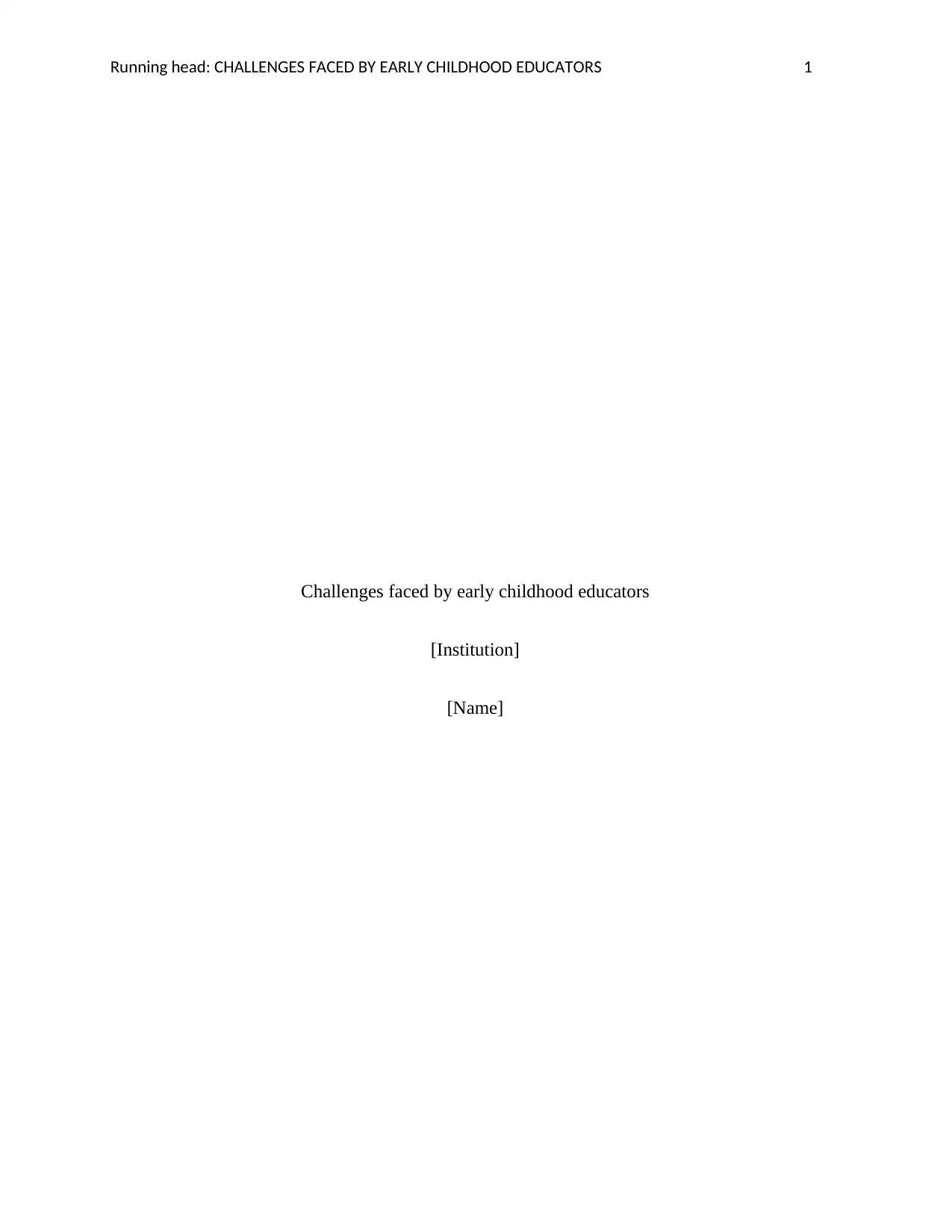
Running head: CHALLENGES FACED BY EARLY CHILDHOOD EDUCATORS 1
Challenges faced by early childhood educators
[Institution]
[Name]
Challenges faced by early childhood educators
[Institution]
[Name]
Paraphrase This Document
Need a fresh take? Get an instant paraphrase of this document with our AI Paraphraser
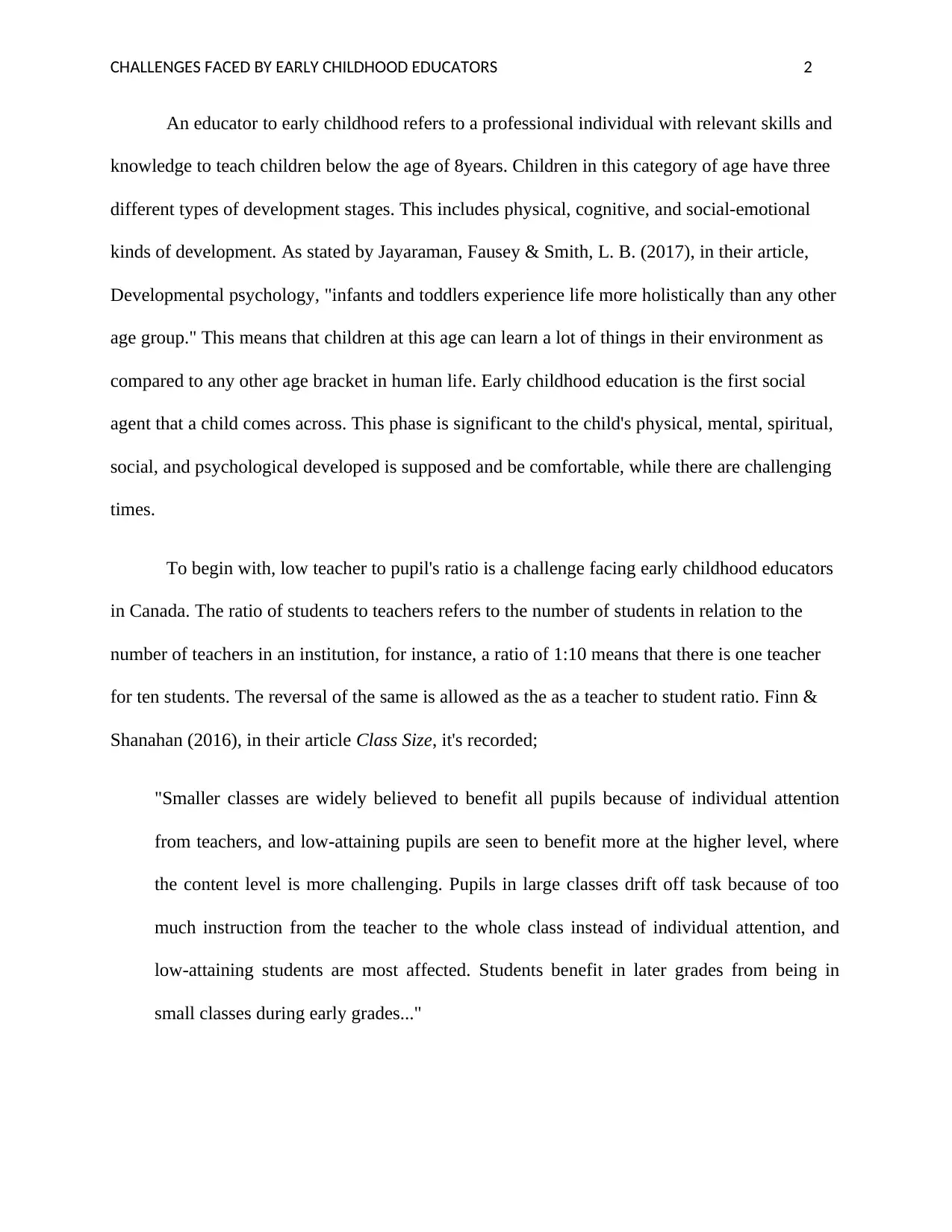
CHALLENGES FACED BY EARLY CHILDHOOD EDUCATORS 2
An educator to early childhood refers to a professional individual with relevant skills and
knowledge to teach children below the age of 8years. Children in this category of age have three
different types of development stages. This includes physical, cognitive, and social-emotional
kinds of development. As stated by Jayaraman, Fausey & Smith, L. B. (2017), in their article,
Developmental psychology, "infants and toddlers experience life more holistically than any other
age group." This means that children at this age can learn a lot of things in their environment as
compared to any other age bracket in human life. Early childhood education is the first social
agent that a child comes across. This phase is significant to the child's physical, mental, spiritual,
social, and psychological developed is supposed and be comfortable, while there are challenging
times.
To begin with, low teacher to pupil's ratio is a challenge facing early childhood educators
in Canada. The ratio of students to teachers refers to the number of students in relation to the
number of teachers in an institution, for instance, a ratio of 1:10 means that there is one teacher
for ten students. The reversal of the same is allowed as the as a teacher to student ratio. Finn &
Shanahan (2016), in their article Class Size, it's recorded;
"Smaller classes are widely believed to benefit all pupils because of individual attention
from teachers, and low-attaining pupils are seen to benefit more at the higher level, where
the content level is more challenging. Pupils in large classes drift off task because of too
much instruction from the teacher to the whole class instead of individual attention, and
low-attaining students are most affected. Students benefit in later grades from being in
small classes during early grades..."
An educator to early childhood refers to a professional individual with relevant skills and
knowledge to teach children below the age of 8years. Children in this category of age have three
different types of development stages. This includes physical, cognitive, and social-emotional
kinds of development. As stated by Jayaraman, Fausey & Smith, L. B. (2017), in their article,
Developmental psychology, "infants and toddlers experience life more holistically than any other
age group." This means that children at this age can learn a lot of things in their environment as
compared to any other age bracket in human life. Early childhood education is the first social
agent that a child comes across. This phase is significant to the child's physical, mental, spiritual,
social, and psychological developed is supposed and be comfortable, while there are challenging
times.
To begin with, low teacher to pupil's ratio is a challenge facing early childhood educators
in Canada. The ratio of students to teachers refers to the number of students in relation to the
number of teachers in an institution, for instance, a ratio of 1:10 means that there is one teacher
for ten students. The reversal of the same is allowed as the as a teacher to student ratio. Finn &
Shanahan (2016), in their article Class Size, it's recorded;
"Smaller classes are widely believed to benefit all pupils because of individual attention
from teachers, and low-attaining pupils are seen to benefit more at the higher level, where
the content level is more challenging. Pupils in large classes drift off task because of too
much instruction from the teacher to the whole class instead of individual attention, and
low-attaining students are most affected. Students benefit in later grades from being in
small classes during early grades..."
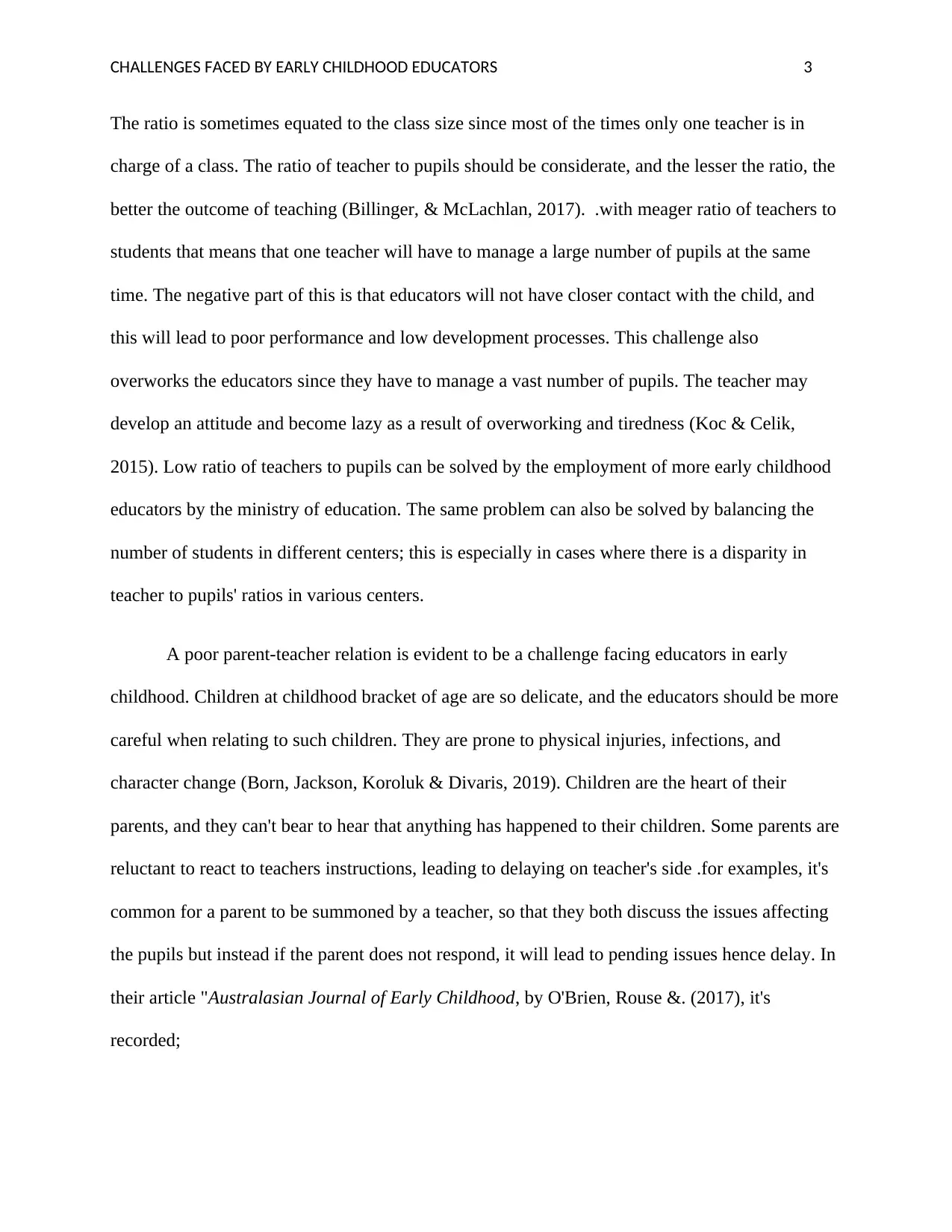
CHALLENGES FACED BY EARLY CHILDHOOD EDUCATORS 3
The ratio is sometimes equated to the class size since most of the times only one teacher is in
charge of a class. The ratio of teacher to pupils should be considerate, and the lesser the ratio, the
better the outcome of teaching (Billinger, & McLachlan, 2017). .with meager ratio of teachers to
students that means that one teacher will have to manage a large number of pupils at the same
time. The negative part of this is that educators will not have closer contact with the child, and
this will lead to poor performance and low development processes. This challenge also
overworks the educators since they have to manage a vast number of pupils. The teacher may
develop an attitude and become lazy as a result of overworking and tiredness (Koc & Celik,
2015). Low ratio of teachers to pupils can be solved by the employment of more early childhood
educators by the ministry of education. The same problem can also be solved by balancing the
number of students in different centers; this is especially in cases where there is a disparity in
teacher to pupils' ratios in various centers.
A poor parent-teacher relation is evident to be a challenge facing educators in early
childhood. Children at childhood bracket of age are so delicate, and the educators should be more
careful when relating to such children. They are prone to physical injuries, infections, and
character change (Born, Jackson, Koroluk & Divaris, 2019). Children are the heart of their
parents, and they can't bear to hear that anything has happened to their children. Some parents are
reluctant to react to teachers instructions, leading to delaying on teacher's side .for examples, it's
common for a parent to be summoned by a teacher, so that they both discuss the issues affecting
the pupils but instead if the parent does not respond, it will lead to pending issues hence delay. In
their article "Australasian Journal of Early Childhood, by O'Brien, Rouse &. (2017), it's
recorded;
The ratio is sometimes equated to the class size since most of the times only one teacher is in
charge of a class. The ratio of teacher to pupils should be considerate, and the lesser the ratio, the
better the outcome of teaching (Billinger, & McLachlan, 2017). .with meager ratio of teachers to
students that means that one teacher will have to manage a large number of pupils at the same
time. The negative part of this is that educators will not have closer contact with the child, and
this will lead to poor performance and low development processes. This challenge also
overworks the educators since they have to manage a vast number of pupils. The teacher may
develop an attitude and become lazy as a result of overworking and tiredness (Koc & Celik,
2015). Low ratio of teachers to pupils can be solved by the employment of more early childhood
educators by the ministry of education. The same problem can also be solved by balancing the
number of students in different centers; this is especially in cases where there is a disparity in
teacher to pupils' ratios in various centers.
A poor parent-teacher relation is evident to be a challenge facing educators in early
childhood. Children at childhood bracket of age are so delicate, and the educators should be more
careful when relating to such children. They are prone to physical injuries, infections, and
character change (Born, Jackson, Koroluk & Divaris, 2019). Children are the heart of their
parents, and they can't bear to hear that anything has happened to their children. Some parents are
reluctant to react to teachers instructions, leading to delaying on teacher's side .for examples, it's
common for a parent to be summoned by a teacher, so that they both discuss the issues affecting
the pupils but instead if the parent does not respond, it will lead to pending issues hence delay. In
their article "Australasian Journal of Early Childhood, by O'Brien, Rouse &. (2017), it's
recorded;
⊘ This is a preview!⊘
Do you want full access?
Subscribe today to unlock all pages.

Trusted by 1+ million students worldwide

CHALLENGES FACED BY EARLY CHILDHOOD EDUCATORS 4
"Parent-teacher relations don't just happen. They are built over time through consistent
communication, collaboration, creative problem solving, and a common goal and, most
importantly, trust. Because teachers change every year, the constants in these relationships
are the parents and children. So it's essential that parents develop leadership skills in setting
clear goals (beyond testing), have meaningful and productive conversations, and create an
action plan for supporting their child in the short-term and …"
Also, some parents are involved in doing assignments meant for the children; this can lead to
poor interpretation by the teacher on the students work. All results to the poor relationship
between the teacher and parents. And this finally affects the pupil’s performance in one way or
the other. Developing of parent-teacher relation improves children performance. Such a
challenge can be solved by, enlightening parents on the importance of the early childhood
education on the life of a child and also the role of early childhood educators to the learning
process of the child (Dowling, & Pound, 2018).
Lastly, Lack of learning resources and facilities in early childhood centers is a challenge
facing early childhood educators. Recourses and facilities are the backbones of early childhood
education. Epstein, (2018), argues that;
“Improving the quality of school facilities is an expensive undertaking. However, when
the positive impacts of facility improvement on teachers and students are translated into
dollar figures, the rewards of such investments far outstrip the cost of the investments…”
Children at this age usually learn by visual and physical means. Hence facilities are very
importance requirement (Shaari & Ahmad, 2016). An example of facilities includes; equipped
standard learning rooms, playing grounds and stationery. Learning resources can also be seen in
"Parent-teacher relations don't just happen. They are built over time through consistent
communication, collaboration, creative problem solving, and a common goal and, most
importantly, trust. Because teachers change every year, the constants in these relationships
are the parents and children. So it's essential that parents develop leadership skills in setting
clear goals (beyond testing), have meaningful and productive conversations, and create an
action plan for supporting their child in the short-term and …"
Also, some parents are involved in doing assignments meant for the children; this can lead to
poor interpretation by the teacher on the students work. All results to the poor relationship
between the teacher and parents. And this finally affects the pupil’s performance in one way or
the other. Developing of parent-teacher relation improves children performance. Such a
challenge can be solved by, enlightening parents on the importance of the early childhood
education on the life of a child and also the role of early childhood educators to the learning
process of the child (Dowling, & Pound, 2018).
Lastly, Lack of learning resources and facilities in early childhood centers is a challenge
facing early childhood educators. Recourses and facilities are the backbones of early childhood
education. Epstein, (2018), argues that;
“Improving the quality of school facilities is an expensive undertaking. However, when
the positive impacts of facility improvement on teachers and students are translated into
dollar figures, the rewards of such investments far outstrip the cost of the investments…”
Children at this age usually learn by visual and physical means. Hence facilities are very
importance requirement (Shaari & Ahmad, 2016). An example of facilities includes; equipped
standard learning rooms, playing grounds and stationery. Learning resources can also be seen in
Paraphrase This Document
Need a fresh take? Get an instant paraphrase of this document with our AI Paraphraser
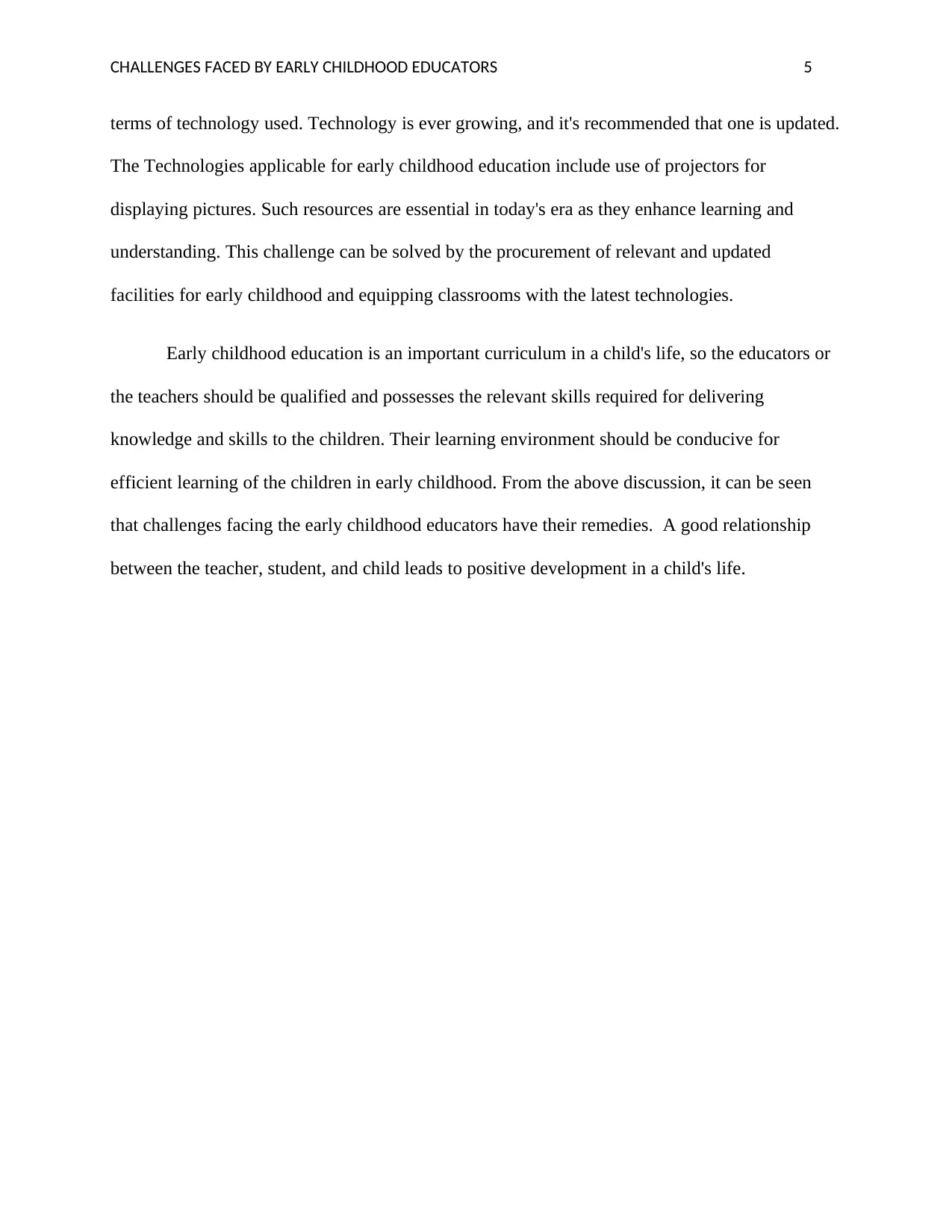
CHALLENGES FACED BY EARLY CHILDHOOD EDUCATORS 5
terms of technology used. Technology is ever growing, and it's recommended that one is updated.
The Technologies applicable for early childhood education include use of projectors for
displaying pictures. Such resources are essential in today's era as they enhance learning and
understanding. This challenge can be solved by the procurement of relevant and updated
facilities for early childhood and equipping classrooms with the latest technologies.
Early childhood education is an important curriculum in a child's life, so the educators or
the teachers should be qualified and possesses the relevant skills required for delivering
knowledge and skills to the children. Their learning environment should be conducive for
efficient learning of the children in early childhood. From the above discussion, it can be seen
that challenges facing the early childhood educators have their remedies. A good relationship
between the teacher, student, and child leads to positive development in a child's life.
terms of technology used. Technology is ever growing, and it's recommended that one is updated.
The Technologies applicable for early childhood education include use of projectors for
displaying pictures. Such resources are essential in today's era as they enhance learning and
understanding. This challenge can be solved by the procurement of relevant and updated
facilities for early childhood and equipping classrooms with the latest technologies.
Early childhood education is an important curriculum in a child's life, so the educators or
the teachers should be qualified and possesses the relevant skills required for delivering
knowledge and skills to the children. Their learning environment should be conducive for
efficient learning of the children in early childhood. From the above discussion, it can be seen
that challenges facing the early childhood educators have their remedies. A good relationship
between the teacher, student, and child leads to positive development in a child's life.
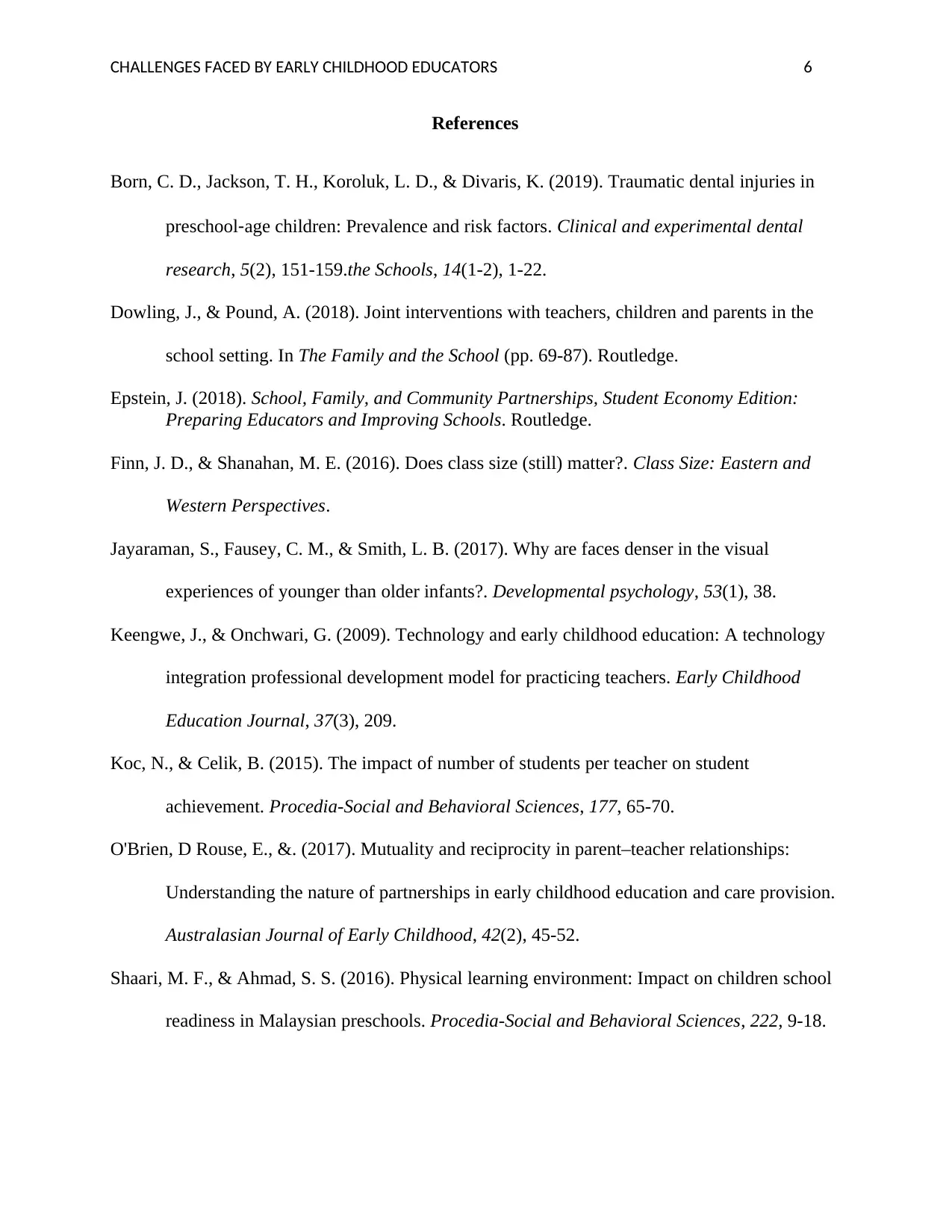
CHALLENGES FACED BY EARLY CHILDHOOD EDUCATORS 6
References
Born, C. D., Jackson, T. H., Koroluk, L. D., & Divaris, K. (2019). Traumatic dental injuries in
preschool‐age children: Prevalence and risk factors. Clinical and experimental dental
research, 5(2), 151-159.the Schools, 14(1-2), 1-22.
Dowling, J., & Pound, A. (2018). Joint interventions with teachers, children and parents in the
school setting. In The Family and the School (pp. 69-87). Routledge.
Epstein, J. (2018). School, Family, and Community Partnerships, Student Economy Edition:
Preparing Educators and Improving Schools. Routledge.
Finn, J. D., & Shanahan, M. E. (2016). Does class size (still) matter?. Class Size: Eastern and
Western Perspectives.
Jayaraman, S., Fausey, C. M., & Smith, L. B. (2017). Why are faces denser in the visual
experiences of younger than older infants?. Developmental psychology, 53(1), 38.
Keengwe, J., & Onchwari, G. (2009). Technology and early childhood education: A technology
integration professional development model for practicing teachers. Early Childhood
Education Journal, 37(3), 209.
Koc, N., & Celik, B. (2015). The impact of number of students per teacher on student
achievement. Procedia-Social and Behavioral Sciences, 177, 65-70.
O'Brien, D Rouse, E., &. (2017). Mutuality and reciprocity in parent–teacher relationships:
Understanding the nature of partnerships in early childhood education and care provision.
Australasian Journal of Early Childhood, 42(2), 45-52.
Shaari, M. F., & Ahmad, S. S. (2016). Physical learning environment: Impact on children school
readiness in Malaysian preschools. Procedia-Social and Behavioral Sciences, 222, 9-18.
References
Born, C. D., Jackson, T. H., Koroluk, L. D., & Divaris, K. (2019). Traumatic dental injuries in
preschool‐age children: Prevalence and risk factors. Clinical and experimental dental
research, 5(2), 151-159.the Schools, 14(1-2), 1-22.
Dowling, J., & Pound, A. (2018). Joint interventions with teachers, children and parents in the
school setting. In The Family and the School (pp. 69-87). Routledge.
Epstein, J. (2018). School, Family, and Community Partnerships, Student Economy Edition:
Preparing Educators and Improving Schools. Routledge.
Finn, J. D., & Shanahan, M. E. (2016). Does class size (still) matter?. Class Size: Eastern and
Western Perspectives.
Jayaraman, S., Fausey, C. M., & Smith, L. B. (2017). Why are faces denser in the visual
experiences of younger than older infants?. Developmental psychology, 53(1), 38.
Keengwe, J., & Onchwari, G. (2009). Technology and early childhood education: A technology
integration professional development model for practicing teachers. Early Childhood
Education Journal, 37(3), 209.
Koc, N., & Celik, B. (2015). The impact of number of students per teacher on student
achievement. Procedia-Social and Behavioral Sciences, 177, 65-70.
O'Brien, D Rouse, E., &. (2017). Mutuality and reciprocity in parent–teacher relationships:
Understanding the nature of partnerships in early childhood education and care provision.
Australasian Journal of Early Childhood, 42(2), 45-52.
Shaari, M. F., & Ahmad, S. S. (2016). Physical learning environment: Impact on children school
readiness in Malaysian preschools. Procedia-Social and Behavioral Sciences, 222, 9-18.
⊘ This is a preview!⊘
Do you want full access?
Subscribe today to unlock all pages.

Trusted by 1+ million students worldwide
1 out of 6
Related Documents
Your All-in-One AI-Powered Toolkit for Academic Success.
+13062052269
info@desklib.com
Available 24*7 on WhatsApp / Email
![[object Object]](/_next/static/media/star-bottom.7253800d.svg)
Unlock your academic potential
Copyright © 2020–2025 A2Z Services. All Rights Reserved. Developed and managed by ZUCOL.




